Health Information Exchange in Nursing: An Assignment Analysis
VerifiedAdded on 2022/10/06
|6
|1748
|22
Report
AI Summary
This nursing assignment report delves into the Health Information Exchange (HIE) system, a crucial component of modern healthcare. The report explores the HIE's function in managing and circulating patient health information within healthcare organizations, highlighting its role in providing efficient, effective, and timely patient care. It examines the system's data security measures, adherence to federal regulations like HIPAA, and its impact on patient safety and research. The report further discusses the opportunities and challenges for nurses in utilizing HIE, emphasizing the importance of data retrieval, system improvements, and the need for robust data management to enhance patient outcomes. The analysis covers the advantages of HIE, such as improved access to patient data and its contribution to healthcare research, while also addressing potential drawbacks like time efficiency in data retrieval and the need for patient consent.
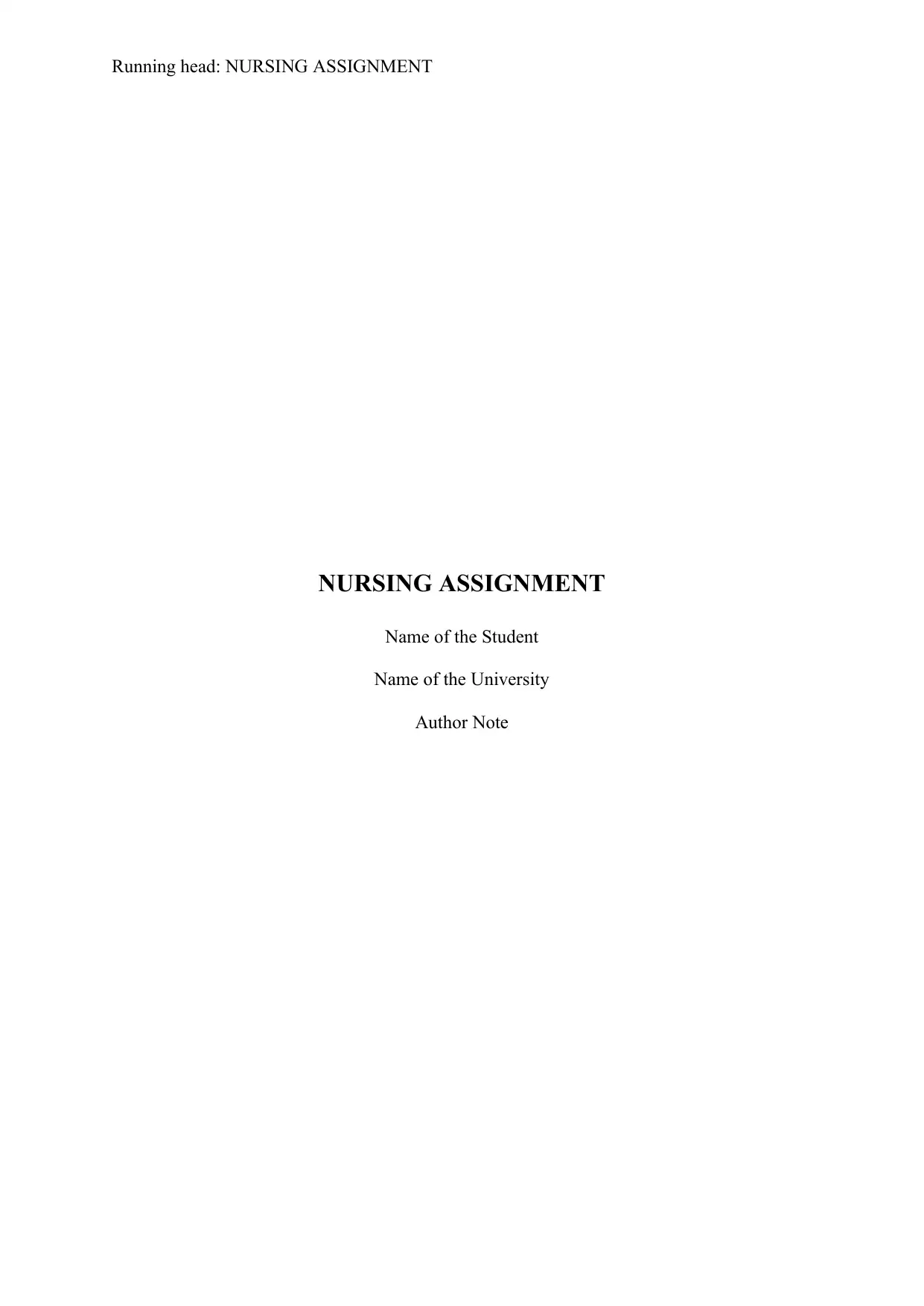
Running head: NURSING ASSIGNMENT
NURSING ASSIGNMENT
Name of the Student
Name of the University
Author Note
NURSING ASSIGNMENT
Name of the Student
Name of the University
Author Note
Paraphrase This Document
Need a fresh take? Get an instant paraphrase of this document with our AI Paraphraser
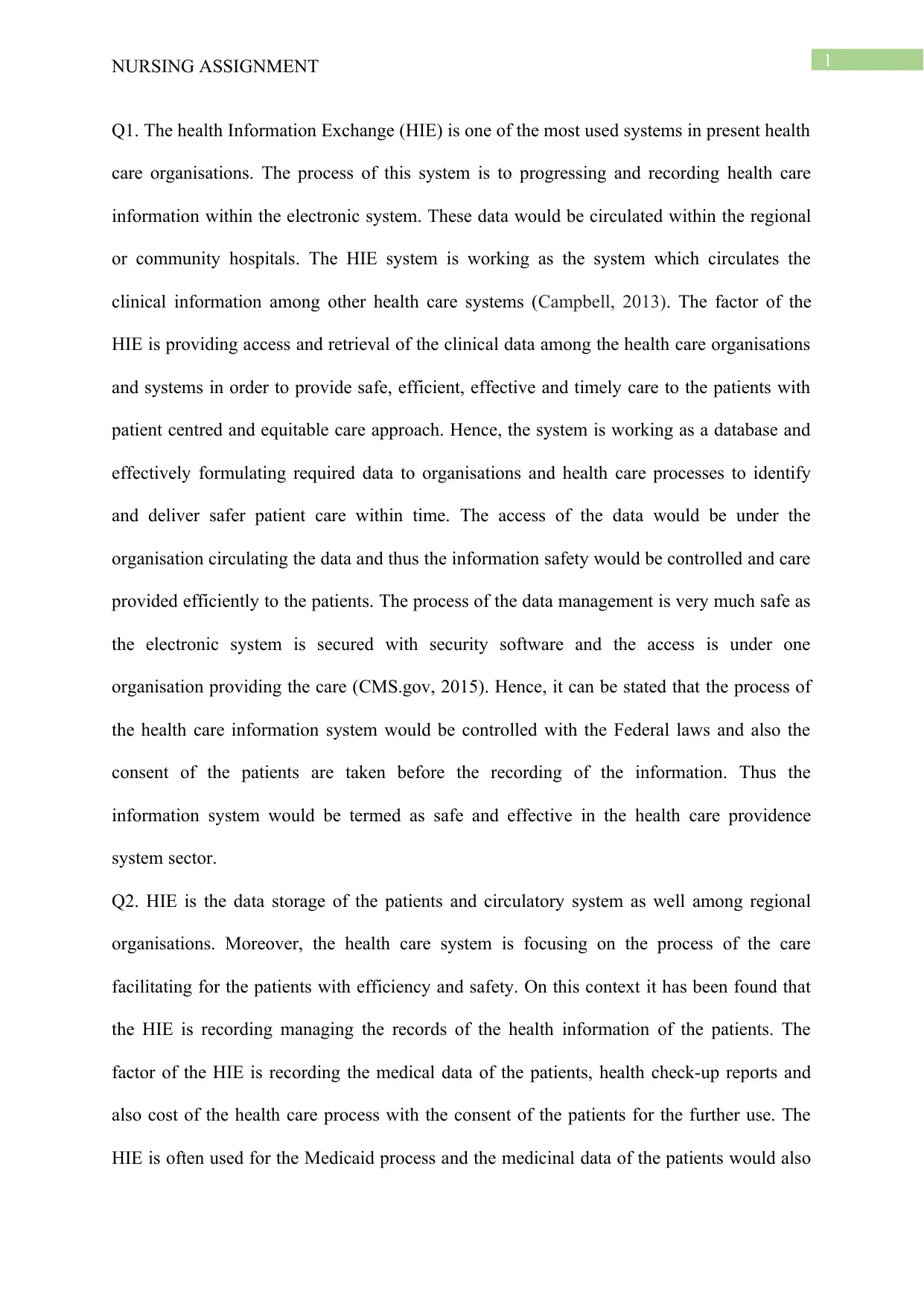
1NURSING ASSIGNMENT
Q1. The health Information Exchange (HIE) is one of the most used systems in present health
care organisations. The process of this system is to progressing and recording health care
information within the electronic system. These data would be circulated within the regional
or community hospitals. The HIE system is working as the system which circulates the
clinical information among other health care systems (Campbell, 2013). The factor of the
HIE is providing access and retrieval of the clinical data among the health care organisations
and systems in order to provide safe, efficient, effective and timely care to the patients with
patient centred and equitable care approach. Hence, the system is working as a database and
effectively formulating required data to organisations and health care processes to identify
and deliver safer patient care within time. The access of the data would be under the
organisation circulating the data and thus the information safety would be controlled and care
provided efficiently to the patients. The process of the data management is very much safe as
the electronic system is secured with security software and the access is under one
organisation providing the care (CMS.gov, 2015). Hence, it can be stated that the process of
the health care information system would be controlled with the Federal laws and also the
consent of the patients are taken before the recording of the information. Thus the
information system would be termed as safe and effective in the health care providence
system sector.
Q2. HIE is the data storage of the patients and circulatory system as well among regional
organisations. Moreover, the health care system is focusing on the process of the care
facilitating for the patients with efficiency and safety. On this context it has been found that
the HIE is recording managing the records of the health information of the patients. The
factor of the HIE is recording the medical data of the patients, health check-up reports and
also cost of the health care process with the consent of the patients for the further use. The
HIE is often used for the Medicaid process and the medicinal data of the patients would also
Q1. The health Information Exchange (HIE) is one of the most used systems in present health
care organisations. The process of this system is to progressing and recording health care
information within the electronic system. These data would be circulated within the regional
or community hospitals. The HIE system is working as the system which circulates the
clinical information among other health care systems (Campbell, 2013). The factor of the
HIE is providing access and retrieval of the clinical data among the health care organisations
and systems in order to provide safe, efficient, effective and timely care to the patients with
patient centred and equitable care approach. Hence, the system is working as a database and
effectively formulating required data to organisations and health care processes to identify
and deliver safer patient care within time. The access of the data would be under the
organisation circulating the data and thus the information safety would be controlled and care
provided efficiently to the patients. The process of the data management is very much safe as
the electronic system is secured with security software and the access is under one
organisation providing the care (CMS.gov, 2015). Hence, it can be stated that the process of
the health care information system would be controlled with the Federal laws and also the
consent of the patients are taken before the recording of the information. Thus the
information system would be termed as safe and effective in the health care providence
system sector.
Q2. HIE is the data storage of the patients and circulatory system as well among regional
organisations. Moreover, the health care system is focusing on the process of the care
facilitating for the patients with efficiency and safety. On this context it has been found that
the HIE is recording managing the records of the health information of the patients. The
factor of the HIE is recording the medical data of the patients, health check-up reports and
also cost of the health care process with the consent of the patients for the further use. The
HIE is often used for the Medicaid process and the medicinal data of the patients would also
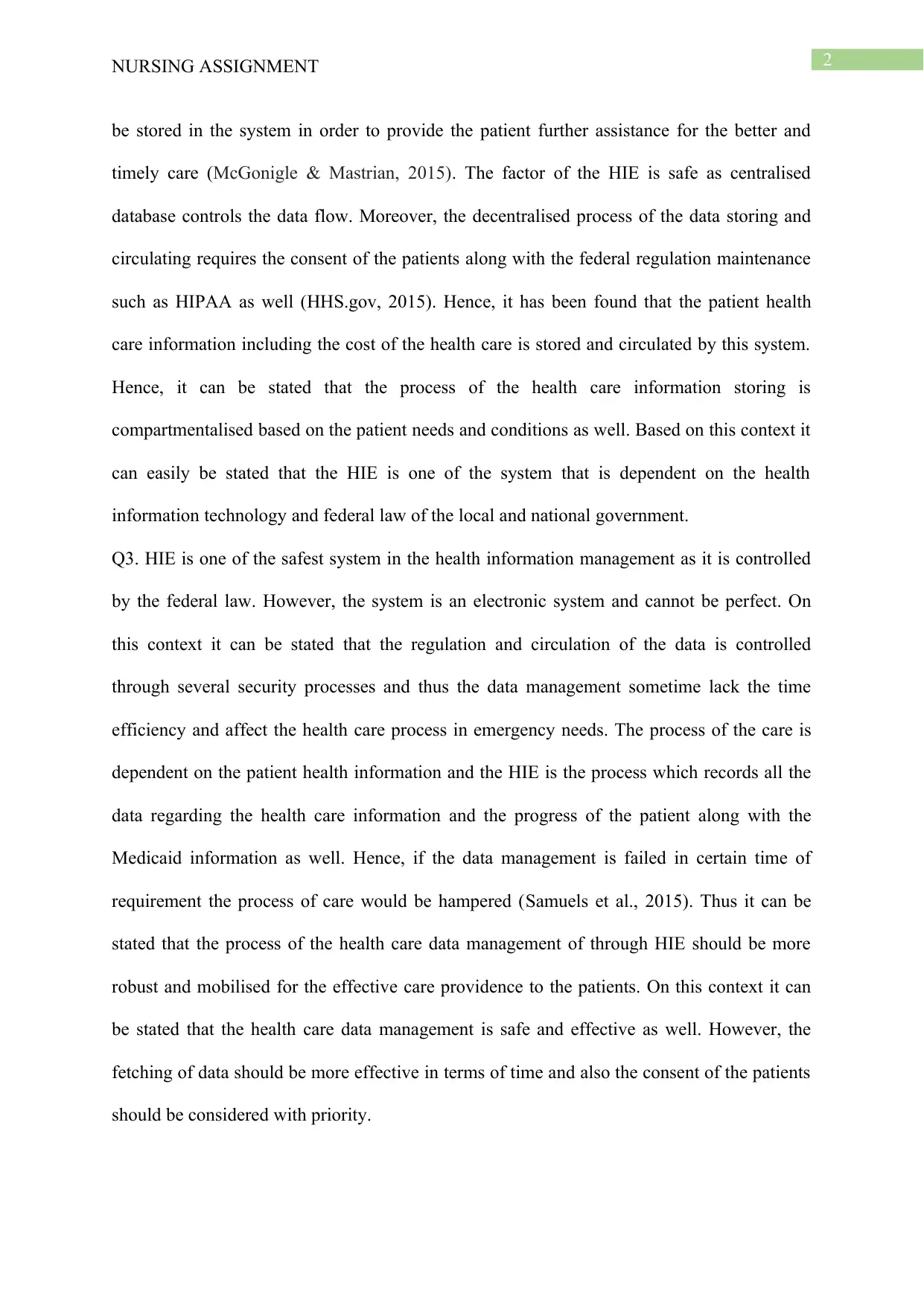
2NURSING ASSIGNMENT
be stored in the system in order to provide the patient further assistance for the better and
timely care (McGonigle & Mastrian, 2015). The factor of the HIE is safe as centralised
database controls the data flow. Moreover, the decentralised process of the data storing and
circulating requires the consent of the patients along with the federal regulation maintenance
such as HIPAA as well (HHS.gov, 2015). Hence, it has been found that the patient health
care information including the cost of the health care is stored and circulated by this system.
Hence, it can be stated that the process of the health care information storing is
compartmentalised based on the patient needs and conditions as well. Based on this context it
can easily be stated that the HIE is one of the system that is dependent on the health
information technology and federal law of the local and national government.
Q3. HIE is one of the safest system in the health information management as it is controlled
by the federal law. However, the system is an electronic system and cannot be perfect. On
this context it can be stated that the regulation and circulation of the data is controlled
through several security processes and thus the data management sometime lack the time
efficiency and affect the health care process in emergency needs. The process of the care is
dependent on the patient health information and the HIE is the process which records all the
data regarding the health care information and the progress of the patient along with the
Medicaid information as well. Hence, if the data management is failed in certain time of
requirement the process of care would be hampered (Samuels et al., 2015). Thus it can be
stated that the process of the health care data management of through HIE should be more
robust and mobilised for the effective care providence to the patients. On this context it can
be stated that the health care data management is safe and effective as well. However, the
fetching of data should be more effective in terms of time and also the consent of the patients
should be considered with priority.
be stored in the system in order to provide the patient further assistance for the better and
timely care (McGonigle & Mastrian, 2015). The factor of the HIE is safe as centralised
database controls the data flow. Moreover, the decentralised process of the data storing and
circulating requires the consent of the patients along with the federal regulation maintenance
such as HIPAA as well (HHS.gov, 2015). Hence, it has been found that the patient health
care information including the cost of the health care is stored and circulated by this system.
Hence, it can be stated that the process of the health care information storing is
compartmentalised based on the patient needs and conditions as well. Based on this context it
can easily be stated that the HIE is one of the system that is dependent on the health
information technology and federal law of the local and national government.
Q3. HIE is one of the safest system in the health information management as it is controlled
by the federal law. However, the system is an electronic system and cannot be perfect. On
this context it can be stated that the regulation and circulation of the data is controlled
through several security processes and thus the data management sometime lack the time
efficiency and affect the health care process in emergency needs. The process of the care is
dependent on the patient health information and the HIE is the process which records all the
data regarding the health care information and the progress of the patient along with the
Medicaid information as well. Hence, if the data management is failed in certain time of
requirement the process of care would be hampered (Samuels et al., 2015). Thus it can be
stated that the process of the health care data management of through HIE should be more
robust and mobilised for the effective care providence to the patients. On this context it can
be stated that the health care data management is safe and effective as well. However, the
fetching of data should be more effective in terms of time and also the consent of the patients
should be considered with priority.
⊘ This is a preview!⊘
Do you want full access?
Subscribe today to unlock all pages.

Trusted by 1+ million students worldwide
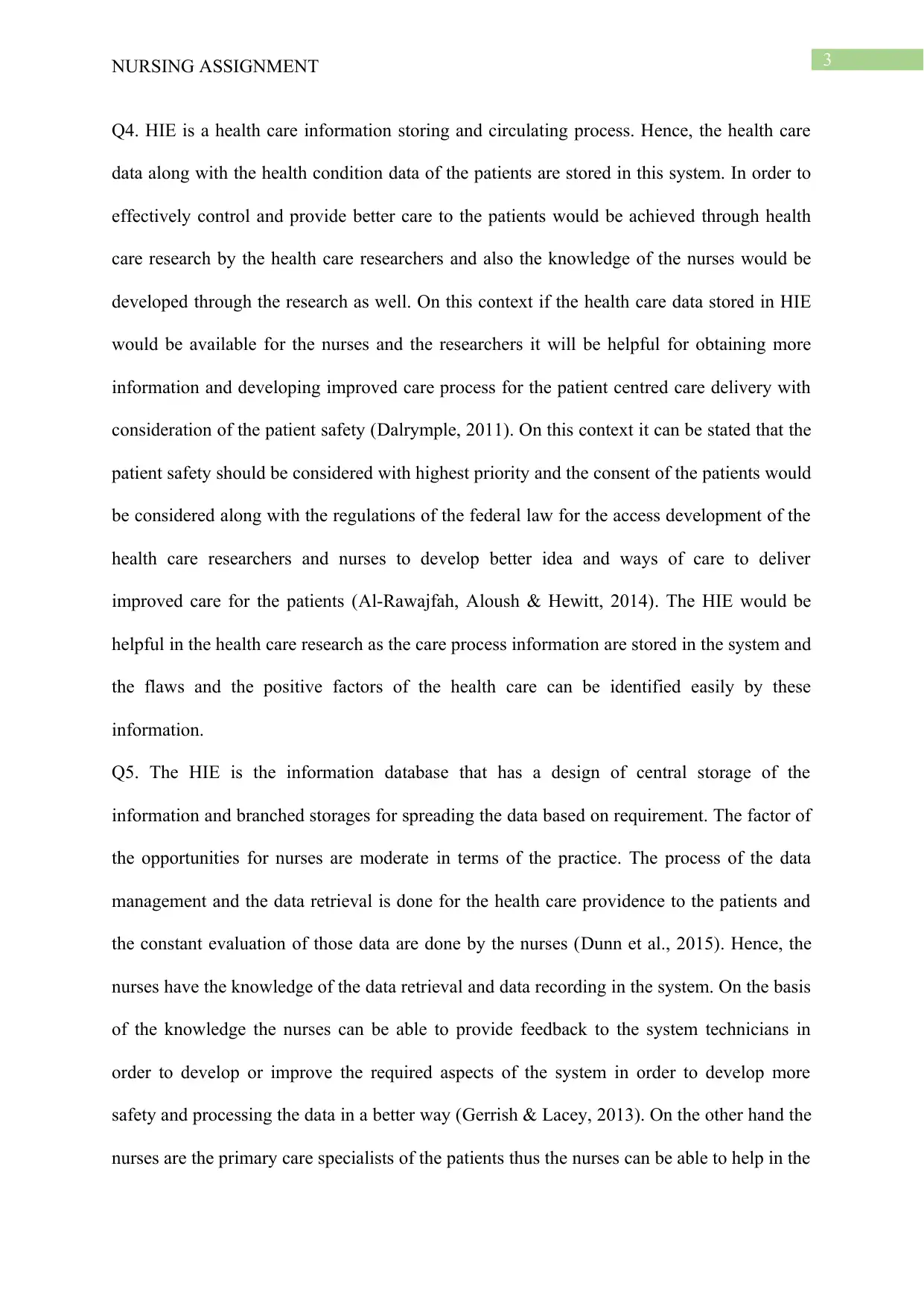
3NURSING ASSIGNMENT
Q4. HIE is a health care information storing and circulating process. Hence, the health care
data along with the health condition data of the patients are stored in this system. In order to
effectively control and provide better care to the patients would be achieved through health
care research by the health care researchers and also the knowledge of the nurses would be
developed through the research as well. On this context if the health care data stored in HIE
would be available for the nurses and the researchers it will be helpful for obtaining more
information and developing improved care process for the patient centred care delivery with
consideration of the patient safety (Dalrymple, 2011). On this context it can be stated that the
patient safety should be considered with highest priority and the consent of the patients would
be considered along with the regulations of the federal law for the access development of the
health care researchers and nurses to develop better idea and ways of care to deliver
improved care for the patients (Al-Rawajfah, Aloush & Hewitt, 2014). The HIE would be
helpful in the health care research as the care process information are stored in the system and
the flaws and the positive factors of the health care can be identified easily by these
information.
Q5. The HIE is the information database that has a design of central storage of the
information and branched storages for spreading the data based on requirement. The factor of
the opportunities for nurses are moderate in terms of the practice. The process of the data
management and the data retrieval is done for the health care providence to the patients and
the constant evaluation of those data are done by the nurses (Dunn et al., 2015). Hence, the
nurses have the knowledge of the data retrieval and data recording in the system. On the basis
of the knowledge the nurses can be able to provide feedback to the system technicians in
order to develop or improve the required aspects of the system in order to develop more
safety and processing the data in a better way (Gerrish & Lacey, 2013). On the other hand the
nurses are the primary care specialists of the patients thus the nurses can be able to help in the
Q4. HIE is a health care information storing and circulating process. Hence, the health care
data along with the health condition data of the patients are stored in this system. In order to
effectively control and provide better care to the patients would be achieved through health
care research by the health care researchers and also the knowledge of the nurses would be
developed through the research as well. On this context if the health care data stored in HIE
would be available for the nurses and the researchers it will be helpful for obtaining more
information and developing improved care process for the patient centred care delivery with
consideration of the patient safety (Dalrymple, 2011). On this context it can be stated that the
patient safety should be considered with highest priority and the consent of the patients would
be considered along with the regulations of the federal law for the access development of the
health care researchers and nurses to develop better idea and ways of care to deliver
improved care for the patients (Al-Rawajfah, Aloush & Hewitt, 2014). The HIE would be
helpful in the health care research as the care process information are stored in the system and
the flaws and the positive factors of the health care can be identified easily by these
information.
Q5. The HIE is the information database that has a design of central storage of the
information and branched storages for spreading the data based on requirement. The factor of
the opportunities for nurses are moderate in terms of the practice. The process of the data
management and the data retrieval is done for the health care providence to the patients and
the constant evaluation of those data are done by the nurses (Dunn et al., 2015). Hence, the
nurses have the knowledge of the data retrieval and data recording in the system. On the basis
of the knowledge the nurses can be able to provide feedback to the system technicians in
order to develop or improve the required aspects of the system in order to develop more
safety and processing the data in a better way (Gerrish & Lacey, 2013). On the other hand the
nurses are the primary care specialists of the patients thus the nurses can be able to help in the
Paraphrase This Document
Need a fresh take? Get an instant paraphrase of this document with our AI Paraphraser
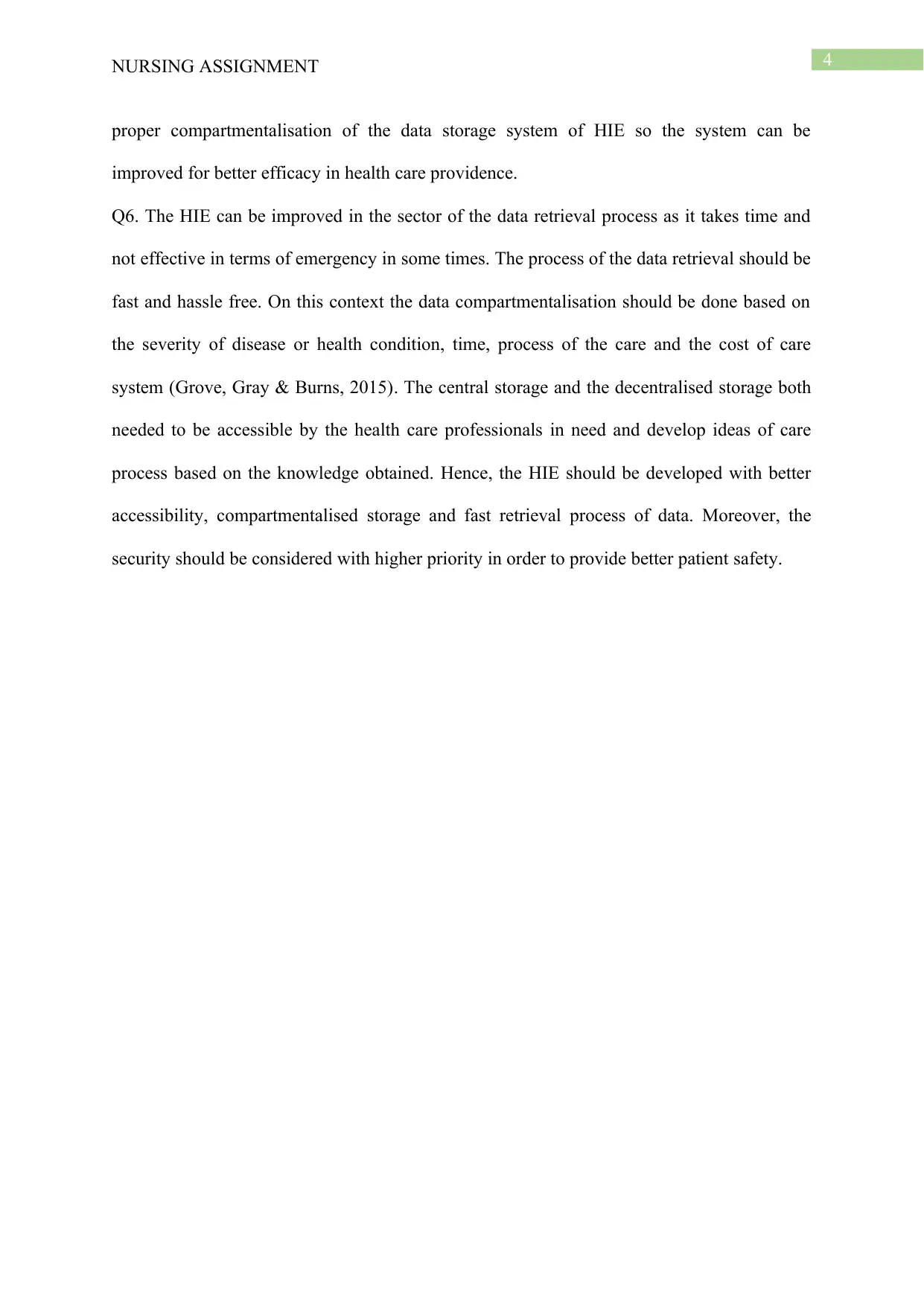
4NURSING ASSIGNMENT
proper compartmentalisation of the data storage system of HIE so the system can be
improved for better efficacy in health care providence.
Q6. The HIE can be improved in the sector of the data retrieval process as it takes time and
not effective in terms of emergency in some times. The process of the data retrieval should be
fast and hassle free. On this context the data compartmentalisation should be done based on
the severity of disease or health condition, time, process of the care and the cost of care
system (Grove, Gray & Burns, 2015). The central storage and the decentralised storage both
needed to be accessible by the health care professionals in need and develop ideas of care
process based on the knowledge obtained. Hence, the HIE should be developed with better
accessibility, compartmentalised storage and fast retrieval process of data. Moreover, the
security should be considered with higher priority in order to provide better patient safety.
proper compartmentalisation of the data storage system of HIE so the system can be
improved for better efficacy in health care providence.
Q6. The HIE can be improved in the sector of the data retrieval process as it takes time and
not effective in terms of emergency in some times. The process of the data retrieval should be
fast and hassle free. On this context the data compartmentalisation should be done based on
the severity of disease or health condition, time, process of the care and the cost of care
system (Grove, Gray & Burns, 2015). The central storage and the decentralised storage both
needed to be accessible by the health care professionals in need and develop ideas of care
process based on the knowledge obtained. Hence, the HIE should be developed with better
accessibility, compartmentalised storage and fast retrieval process of data. Moreover, the
security should be considered with higher priority in order to provide better patient safety.
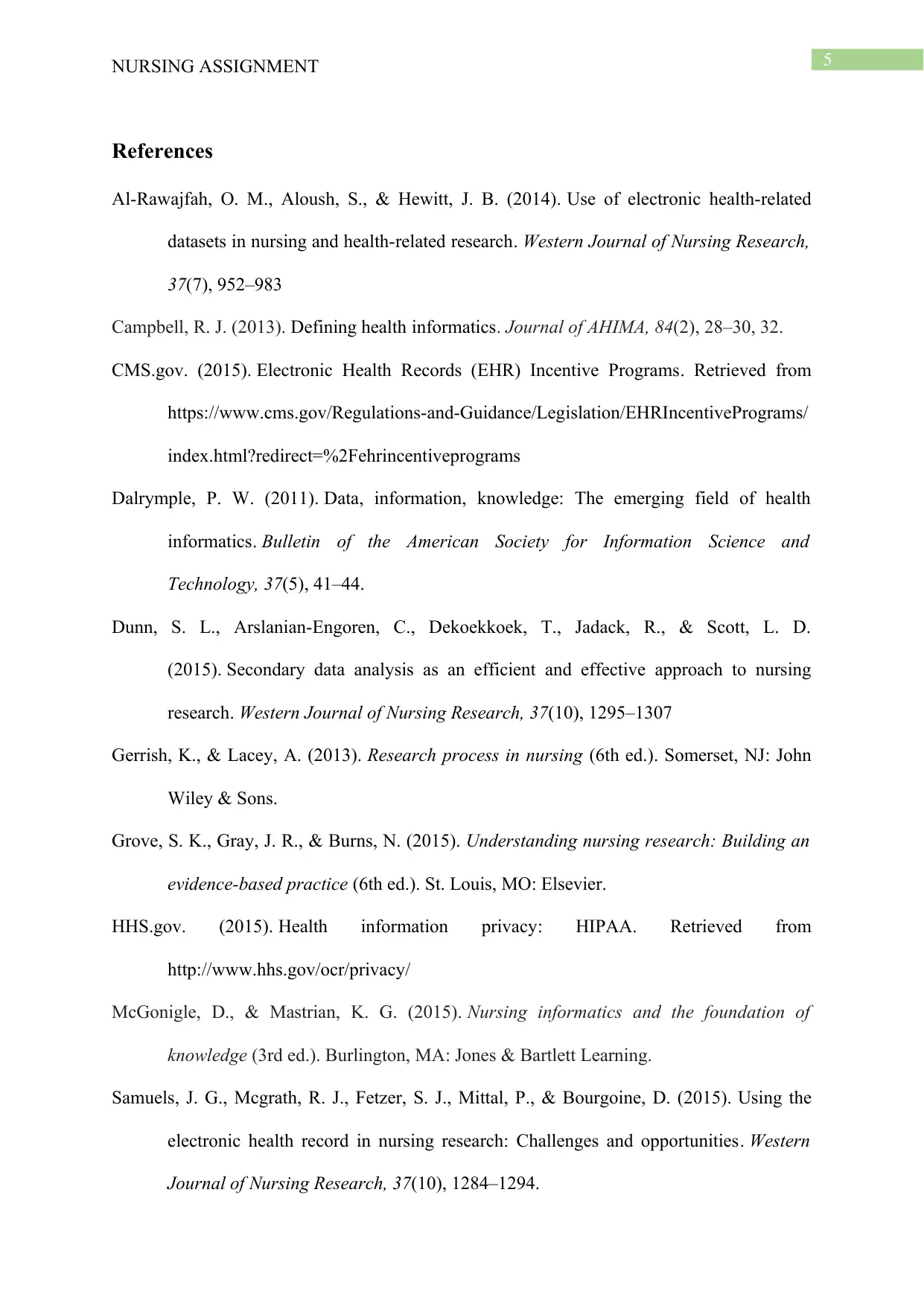
5NURSING ASSIGNMENT
References
Al-Rawajfah, O. M., Aloush, S., & Hewitt, J. B. (2014). Use of electronic health-related
datasets in nursing and health-related research. Western Journal of Nursing Research,
37(7), 952–983
Campbell, R. J. (2013). Defining health informatics. Journal of AHIMA, 84(2), 28–30, 32.
CMS.gov. (2015). Electronic Health Records (EHR) Incentive Programs. Retrieved from
https://www.cms.gov/Regulations-and-Guidance/Legislation/EHRIncentivePrograms/
index.html?redirect=%2Fehrincentiveprograms
Dalrymple, P. W. (2011). Data, information, knowledge: The emerging field of health
informatics. Bulletin of the American Society for Information Science and
Technology, 37(5), 41–44.
Dunn, S. L., Arslanian-Engoren, C., Dekoekkoek, T., Jadack, R., & Scott, L. D.
(2015). Secondary data analysis as an efficient and effective approach to nursing
research. Western Journal of Nursing Research, 37(10), 1295–1307
Gerrish, K., & Lacey, A. (2013). Research process in nursing (6th ed.). Somerset, NJ: John
Wiley & Sons.
Grove, S. K., Gray, J. R., & Burns, N. (2015). Understanding nursing research: Building an
evidence-based practice (6th ed.). St. Louis, MO: Elsevier.
HHS.gov. (2015). Health information privacy: HIPAA. Retrieved from
http://www.hhs.gov/ocr/privacy/
McGonigle, D., & Mastrian, K. G. (2015). Nursing informatics and the foundation of
knowledge (3rd ed.). Burlington, MA: Jones & Bartlett Learning.
Samuels, J. G., Mcgrath, R. J., Fetzer, S. J., Mittal, P., & Bourgoine, D. (2015). Using the
electronic health record in nursing research: Challenges and opportunities. Western
Journal of Nursing Research, 37(10), 1284–1294.
References
Al-Rawajfah, O. M., Aloush, S., & Hewitt, J. B. (2014). Use of electronic health-related
datasets in nursing and health-related research. Western Journal of Nursing Research,
37(7), 952–983
Campbell, R. J. (2013). Defining health informatics. Journal of AHIMA, 84(2), 28–30, 32.
CMS.gov. (2015). Electronic Health Records (EHR) Incentive Programs. Retrieved from
https://www.cms.gov/Regulations-and-Guidance/Legislation/EHRIncentivePrograms/
index.html?redirect=%2Fehrincentiveprograms
Dalrymple, P. W. (2011). Data, information, knowledge: The emerging field of health
informatics. Bulletin of the American Society for Information Science and
Technology, 37(5), 41–44.
Dunn, S. L., Arslanian-Engoren, C., Dekoekkoek, T., Jadack, R., & Scott, L. D.
(2015). Secondary data analysis as an efficient and effective approach to nursing
research. Western Journal of Nursing Research, 37(10), 1295–1307
Gerrish, K., & Lacey, A. (2013). Research process in nursing (6th ed.). Somerset, NJ: John
Wiley & Sons.
Grove, S. K., Gray, J. R., & Burns, N. (2015). Understanding nursing research: Building an
evidence-based practice (6th ed.). St. Louis, MO: Elsevier.
HHS.gov. (2015). Health information privacy: HIPAA. Retrieved from
http://www.hhs.gov/ocr/privacy/
McGonigle, D., & Mastrian, K. G. (2015). Nursing informatics and the foundation of
knowledge (3rd ed.). Burlington, MA: Jones & Bartlett Learning.
Samuels, J. G., Mcgrath, R. J., Fetzer, S. J., Mittal, P., & Bourgoine, D. (2015). Using the
electronic health record in nursing research: Challenges and opportunities. Western
Journal of Nursing Research, 37(10), 1284–1294.
⊘ This is a preview!⊘
Do you want full access?
Subscribe today to unlock all pages.

Trusted by 1+ million students worldwide
1 out of 6
Related Documents
Your All-in-One AI-Powered Toolkit for Academic Success.
+13062052269
info@desklib.com
Available 24*7 on WhatsApp / Email
![[object Object]](/_next/static/media/star-bottom.7253800d.svg)
Unlock your academic potential
Copyright © 2020–2025 A2Z Services. All Rights Reserved. Developed and managed by ZUCOL.





